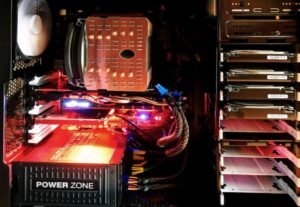Neural Network as Matrix
An important concept in understanding neural networks is viewing them as matrices. Neural networks, a key component of machine learning, are composed of interconnected layers of nodes (neurons) that process information. These networks are often visualized as flowcharts, but the matrix representation provides a deeper understanding of their inner workings.
Key Takeaways:
- Neural networks can be represented as matrices.
- Matrix multiplication enables layer-to-layer computation.
- Weights and biases in matrices determine network behavior.
- Training involves adjusting matrix values to optimize performance.
- Matrix theory provides insights into network architecture and optimization.
**In a neural network, each layer can be represented as a matrix**. The input layer corresponds to the input data, which is usually represented as a column vector. Subsequent hidden layers are represented as matrices, where each row corresponds to a neuron and each column corresponds to a connection weight between neurons. Finally, the output layer is also represented as a matrix, where each row represents an output neuron.
By utilizing **matrix multiplication**, computations can be performed efficiently between layers. Matrix multiplication involves multiplying corresponding elements in each row of the first matrix with the corresponding element in each column of the second matrix, and summing the results. This process allows for the transformation of inputs through multiple layers, enabling the network to learn complex patterns and make predictions.
**Weights and biases are stored in matrices to determine the behavior of the network**. Weights represent the strength of connections between neurons, while biases introduce additional flexibility to the model. These values are initialized randomly and modified during training using optimization algorithms to minimize errors and improve accuracy.
| Layer | Input | Output |
|---|---|---|
| Input | 10×1 | – |
| Hidden | 10×5 | 5×1 |
| Output | 5×1 | – |
**Training a neural network involves adjusting the values within the matrices**. This is typically done through a process called backpropagation, where errors are propagated backwards through the network to update weights and biases. The goal is to minimize the difference between predicted and actual outputs, improving the overall performance of the model.
Matrix theory provides valuable insights into network architecture and optimization. **Eigenvalues and eigenvectors, for example, reveal important information about network stability and convergence**. By understanding the mathematical properties of matrices, researchers can tailor network architectures and optimization techniques for specific tasks and achieve better results.
| Advantages | Examples |
|---|---|
| Efficient computation | Matrix multiplication allows for parallel processing. |
| Mathematical insights | Matrix properties guide network architecture design. |
| Optimization techniques | Matrix decomposition helps improve training speed. |
The matrix representation of neural networks offers an intuitive framework for understanding their operations and behaviors. **By leveraging matrix theory and optimization algorithms, researchers continue to push the boundaries of what neural networks can accomplish in various domains**. As the field evolves, it is crucial to stay updated with the latest advancements and explore the potential applications of neural networks as powerful computational tools.
| Domain | Application |
|---|---|
| Computer Vision | Object recognition, image classification. |
| Natural Language Processing | Language translation, sentiment analysis. |
| Finance | Stock market prediction, fraud detection. |

Common Misconceptions
Neural Network as Matrix
There are some common misconceptions people have about neural networks being equivalent to matrices. While matrices are indeed utilized in several aspects of neural network computation, it is important to understand that neural networks are not solely matrices but rather a complex combination of mathematical operations and interconnected layers of neurons working together.
- Neural networks involve more than just matrix multiplication.
- Not all components of a neural network can be represented as a matrix.
- Matrix dimensions are not the only factor in determining neural network performance.
Matrix Operations Being Simple Equations
Another misconception surrounding neural networks is the belief that matrix operations performed within them are simple and straightforward equations. While matrix operations are indeed fundamental to the functioning of neural networks, they can involve advanced mathematical concepts, such as vector calculus and linear algebra.
- Matrix operations can involve complex mathematical functions.
- Linear algebra plays a significant role in optimizing neural network computations.
- Neural networks involve iterative matrix operations that require careful tuning.
Matrix Size and Neural Network Capacity
Some people believe that the size of the matrices used in neural networks directly determines their capacity and performance. However, the relationship between matrix size and network capacity is not as simplistic as it may seem. Neural network capacity is influenced by various factors such as network architecture, depth, activation functions, and training data.
- Matrix size alone does not determine neural network capacity.
- Network architecture and depth influence performance more than matrix size.
- Training data quality and quantity have a significant impact on network capacity.
Neural Network Weights as Magic Numbers
Weights in a neural network are often misconceived as arbitrary “magic numbers” assigned to connections between neurons, with no logical basis. In reality, these weights are essential parameters that are learned and adjusted during the training process through algorithms like backpropagation. They represent the strength and importance of connections in the network.
- Neural network weights are learned through iterative training processes.
- The values of weights impact the network’s ability to learn and generalize.
- Weight initialization techniques play a crucial role in network training.
Neural Networks as Perfect Problem Solvers
There is a misconception that neural networks can flawlessly solve any problem thrown at them. While neural networks have demonstrated remarkable performance in various tasks, they are not universally perfect problem solvers. Different neural network architectures and configurations are better suited for different problem domains, and careful design and fine-tuning are necessary for optimal results.
- Neural networks have limitations and may struggle with certain problems.
- Choosing the appropriate network architecture is crucial for solving specific problems.
- Generalization and overfitting are challenges in neural network training.

Exploring the Components of a Neural Network
A neural network is a complex system comprised of various components, each with its unique role and significance. The tables below provide an insight into some of the key elements of a neural network, shedding light on their functionalities and contributions. Let’s dive in!
1. Input Layer
The input layer forms the entry point for data into a neural network. It receives the raw features or attributes that are to be processed and analyzed. Here’s an illustration of the input layer:
| Data Type | Number of Nodes | Activation Function |
|---|---|---|
| Numerical | 10 | None |
2. Hidden Layer
The hidden layers exist between the input and output layers, performing computations and transforming the input data. They play a pivotal role in capturing complex relationships within the dataset. Let’s take a look at an example hidden layer:
| Layer Number | Number of Nodes | Activation Function |
|---|---|---|
| 1 | 50 | ReLU |
3. Output Layer
The output layer provides the final results of a neural network’s computation. It maps the transformed input data to the desired output, making predictions or classifications based on the training it has received. Here’s an example of an output layer:
| Data Type | Number of Nodes | Activation Function |
|---|---|---|
| Categorical | 3 | Softmax |
4. Weight Matrix
Neural networks involve numerous interconnected nodes that are assigned weights. These weights determine the importance of the input data in predicting the output. The weight matrix summarizes this information. Take a look at an example:
| Input Node | Output Node | Weight Value |
|---|---|---|
| 1 | A | 0.75 |
| 1 | B | -1.25 |
| 2 | A | 2.45 |
5. Bias Vector
Biases are added to individual nodes in a neural network to adjust the output even when input values are zero. The bias vector summarizes these adjustments. Take a look at an example:
| Node | Bias Value |
|---|---|
| A | 0.5 |
| B | -0.8 |
6. Activation Function
An activation function introduces non-linearity into the neural network, allowing it to model complex relationships between inputs and outputs. Different layers can employ different activation functions. Here’s an example:
| Layer | Activation Function |
|---|---|
| 1 | ReLU |
| 2 | Sigmoid |
7. Loss Function
The loss function quantifies the difference between predicted and actual outputs during the training phase of a neural network. It helps the network adjust its parameters to minimize this difference and improve accuracy. Here’s an example:
| Loss Function | Type |
|---|---|
| Mean Squared Error | Regression |
8. Learning Rate
The learning rate determines how quickly a neural network adapts its weights and biases during the training process. It strikes a balance between swift convergence and overshooting or slow convergence. Here’s an example:
| Learning Rate |
|---|
| 0.001 |
9. Batch Size
Training neural networks with large datasets can be computationally intensive. To alleviate this, data is divided into batches, and the model is trained on each batch sequentially. Batch size influences the accuracy and speed of the training process. Here’s an example:
| Batch Size |
|---|
| 32 |
10. Epochs
Epochs denote the number of times a neural network goes through the entire dataset during training. Considered as a whole, epochs fine-tune the network’s weights and biases, leading to improved accuracy. Here’s an example:
| Number of Epochs |
|---|
| 100 |
In conclusion, neural networks are intricate systems that rely on multiple components working together harmoniously. From the input and hidden layers to the weight matrices and activation functions, each element has a crucial role in transforming data and making accurate predictions. By understanding these elements, we can appreciate the underlying dynamics of neural networks and harness their power for a wide range of applications.




